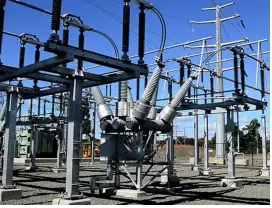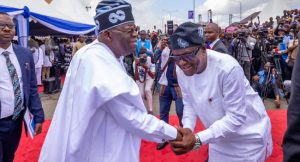Banks get marching order to sell-off DisCos’ shares

Banks holding majority stakes in six electricity distribution companies (DisCos) yesterday got a marching order from the Federal Government to divest within 12 months.
Minister of Power, Abubakar Aliyu, who gave the ultimatum, said the government was monitoring the operations and divestment process of the six DisCos to ensure compliance with the core objectives of restructuring the power firms.
He said the banks have been mandated to find serious investors to sell their 60 per cent equity in the Abuja, Kano, Kaduna, Benin, Ibadan and Port Harcourt DisCos.
Aliyu spoke in Abuja at the 11th edition of the ‘PMB Administration Scorecard Series (2015-2023)’ organised by the Federal Ministry of Information and Culture.
He said the government sacked the previous core investors to make them more responsible, adding that the government was determined to put the DisCos on their feet.
According to him, restructuring of the six Discos included the sacking of the previous core investors due to poor performance and the composition of a new board and management to run them.
The minister said: “For the benefit of the doubt when I say we have restructured the Discos this is just saying it mildly.
“Restructuring means that we have sacked the core investors. We have sacked the management and allowed the lenders to take over.
“Either banks or the Asset Management Corporation of Nigeria (AMCON) hold the franchise.
“So the banks have taken over 60 per cent ownership. We have allowed the banks, the Bureau of Public Enterprises (BPE) and the Central Bank of Nigeria (CBN) to take control.
“The lenders provided the chairmanship of the Discos. The BPE provided part of the management, including the managing directors and then the CBN provided the chief financial officer (CFO) and the auditor.
“So this is the position we are now with the six discos. They are Abuja, Kano, Kaduna, Benin, Ibadan and Port Harcourt. One may ask why only six? What about the rest?
“You know we have 11 of them. Three out of the 11 Discos are performing well, that is two in Lagos and one in Enugu. They are not doing badly.
“Jos Disco was re-concessioned in 2022 and Yola was re-concessioned last year. These two Discos are working very hard to improve. So we have to give time to settle down.
“In a way, we have restructured the whole of the 11 discos in one way or the other. Now, it is to help them since we have made them more responsible.
“We are trying to help them to get on their feet.”
The minister spoke about the Nigeria Distribution Sector Recovery Programme (DISREP).
He said: “It is a loan of $500 million which initially we refused to take for the Discos because of their situation. We don’t trust the way things have been handled.
“So, the loan has been there with the World Bank since last year but we did not take it until when we were able to restructure.
“Even now that Mr. President has approved through the Federal Executive Council, the DISREP, there are some conditions tied to them so that we can remove the risks attached to it. This is the situation.
“I hope and it is not going to be forever because banks are not in the business of providing electricity.
“So we have given them six months to one year to find someone serious to sell their 60 per cent equity to those in the business of electricity. This is the situation now and we are monitoring.”
He said the administration of President Buhari will bequeath 22,000MW capacity to the nation before leaving office next year, adding that Siemens was engaged in the power sector to raise the operational capacity from 7000 MW to 11, 000MW and 25, 000MW in 2025.
On tariffs, he said electricity is not a cheap commodity the world over.
He said Nigerians can cut costs by being careful about how they manage and use electricity, noting that the government was doing its best to protect lower-income citizens because of the nexus between lack of access to electricity and poverty.
The minister said: “We have service band from A to E. Accordingly, Band A will be provided with 22 hours of service. But they have to pay for it. Electricity is not a cheap commodity the world over.
“The cost of gas to power is being subsidised by the government by more than half to cushion the effects of electricity cost to the end users.
“The government used to fill up the gap. It used to be N600 billion per annum for the shortfall. But through some reviews we have been able to reduce it to N152 billion.
“Even at N152 billion the government pays in N152 billion, they take loans to pay in order to cushion the effect for all of us. And you know the situation of government finances nowadays. The government may not be able to continue doing that. We have to gradually live up to that.
Read Also: ‘Allow DISCOs operate as private companies’
“We have to be more careful about how we use electricity and how we are able to manage the electricity in order to reduce the cost by ourselves by using it when it is necessary. So this is the situation we are in.
“We have done all of this while protecting our lower-income citizens (that do not always receive adequate electricity) by maintaining subsidies for the lower tariff bands while allowing those with adequate power to pay relatively higher prices. Tariff shortfalls have been reduced by over 80 per cent and we are on the path to having a sustainable market that can pay for itself.
“We have put a focus on electricity poverty. It is proven through various studies that there is a strong nexus between lack of electricity access and poverty.
“Prior to this administration, there was no coherent policy on Rural Electrification with key provisions of the Electric Power Sector Reform Act to electrify rural populations largely ignored. “This administration established the Rural Electrification Fund that provides up to 70% grants for rural mini-grid and solar home systems. Currently REF has electrified more than 300,000 citizens in its short existence. The Ministry is working with REA to expand the Rural Electrification Fund to create more opportunities for rural access.”
According to him, this administration will bequeath to Nigerians 4,000MW of additional generating capacity. It will complete and commission the 700MW Zungeru Hydro Power Plant in the first quarter of 2023.
“We will also see to the operationalization of the 240MW Afam III and 300MW Okpai Phase II to mention a few. We will set the country on a stable path for 10,000MW of supplied energy (today we are at 8,000MW with 5,000MW on-grid and 3,000MW+ of industrial captive off-grid) and we will leave an installed capacity of almost 22,000MW.
“We also have robust programmes ongoing with facilities and investments secured of over $3 billion to eliminate the large gap between our transmission capacity and supplied energy.
“We have repositioned the Siemens Presidential Power Initiative (PPI) and after a slow start, we have begun to take delivery of critical equipment. You may recall that accelerated orders were placed for 10 power transformers and 10 mobile substations, with a delivery schedule beginning Sep’22. So far, six of the 10 power transformers have already arrived on the shores of Nigeria and we have started installation in various locations while the remaining four are expected in Dec’22 and January 2023. The mobile substations are expected from January 2023 through to April 2023.
“As far as I am concerned, it is a government-to-government collaboration between the Nigerian Government and the German Government through President Muhammadu Buhari and the previous German Chancellor, Angerla Merkel, where Merkel agreed to help in giving us a loan under concessionary terms to bring Siemens to implement the rehabilitation of our infrastructure in three phases. Phase one is to raise the operational capacity from 7000 MW to 11, 000MW to 25, 000MW.
“Phase I is supposed to be a quick one because already the TCN capacity is not matching or rather I would say the discos capacity is not matching with the TCN capacity. There are some interfaces, and infrastructure problems. You may have the capacity of TCN up to 8000MW but there is no evacuation due to some interface problem. So that is what Phase One is set out to do, to quickly take the level to where it is balanced.
“And then Phase Two is to further expand to 11, 000MW, and the Phase Three to take the whole value chain from generation, transmission to distribution through up to 2025 to 25, 000MW. So and the loan is around two million Euros.”
He said the government completed a total of 105 power transformer projects between 2015 to 2022, adding a capacity of 6,216MVA to the national grid.
He listed some of the completed power transformer/substation projects including the 150MVA 330/132kV Interbus Power Transformer at Ughelli, Delta IV transmission substation and the 150MVA 330/132kV power transformer at Ayade Transmission Substation
Others are the 2x150MVA 330/132/33kV Substation at Lafia, Nasarawa State, and the 2x60MVA 132/33kV Dawaki/Gwarinpa Substation which was recently completed in November 2022 under the Abuja Feeding Scheme.
The projects also included the 2x60MVA 132/33kV Gagarawa Substation, 2x60MVA 132/33kV Substation at Adiabor, 2x30MVA 132/33kV Yelwa Yauri the1x30MVA 132/33kV Ilashe Substation and the 1x40MVA 132/33kV Substation at Bichi, Kano State among others.
According to the minister, a number of substations and bay extensions were nearing completion and were expected to be inaugurated by the first and second quarters of 2023.
He said a total of 900km of reconductoring and construction of new transmission lines were completed during the period 2015 – 2022.
Some of the key lines, according to him, included reconductoring of the 140km 132kV Birnin- Kebbi to Sokoto transmission line (April 2021) and the completion of 330kv Aloji – Ikot Ekpene transmission line.
Others were the 132kV Ihovbor – Okada transmission line, completion of 330kv Gombe – Damaturu transmission line, among others.
The minister said some transmission line projects nearing completion and expected to be inaugurated by Q1 and Q2 of 2023 included the Kaduna – Jos Double Circuit Transmission Line and Benin-Ajaokuta 330kV Single Circuit.
He pointed out that the ongoing $2 billion electricity grid maintenance, expansion and rehabilitation programme across the country is estimated to create 45,000 direct and indirect jobs.
He said in delivering the projects, the federal government leveraged the support of the various State Governors to resolve Right of Way (ROW) issues.
He gave the example of the ROW issue recently resolved in Kumbotso-Dan Agundi in Kano which, according to him, lingered for more than 10 years.
(Nation)






32720 679061I see something really particular in this internet website . 253393